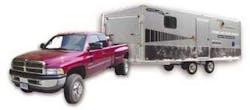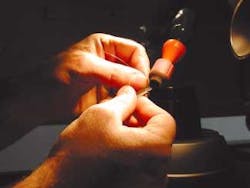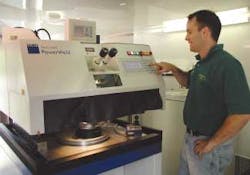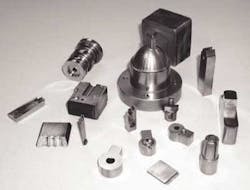Manual welding/cladding, using pulsed Nd:YAG lasers, is a developing process that has recently been introduced to North American tool and moldmakers. Laser energy supplies the heat to fuse tool steel filler wire onto worn tool steel surfaces to achieve superior surface restoration. Two manufacturers offer laser process packages that provide a rapid and convenient method for tool die and plastic injection mold surface restoration.
Laser cladding of tool steel has been used in Europe for some time now, successfully restoring tool steel surfaces for plastic molds and stamping dies. In the U.S. the dominant process for tool steel restoration is Gas Tungsten Arc Welding (GTAW), often referred to as TIG welding or "Micro-Arc Welding." Another, less popular, process that has generated interest is electron beam welding. This article looks at the chronology of tool steel cladding from arc welding through electron beam welding to the introduction of industrial laser processes.
Mobile laser welding lab.
Cladding and welding restoration of tool steel surfaces began with GTAW in the late 1960s. This process is fundamentally straightforward—the transference of a variable electrical current, in the form of an ionized arc, across the controlled gap of an open loop circuit. Typically either argon or helium gas is used to sustain a stable arc as the welder attenuates the arc current with a variable foot potentiometer. The earliest user of tool steel surface restoration was the automotive industry for repair of tool steel stamping dies.
Before the advent of modern electronics GTAW, power supplies were rather basic devices used to generate a large amount of concentrated thermal energy to melt tool steel surfaces and fuse filler onto the surface of defective areas. These early power supplies, with simple controls, were limited to sustaining arc currents in the 5.0- to 10.0-amp range, with arc starting at twice the amperage. This difficult arc starting created a challenge for the skilled welder to form small and precise weld beads consistently.
Over the next 30 years GTAW evolved into a highly refined process through the development of sophisticated power supplies, which utilize signal conditioning, inverter technology, microprocessors and closed-loop circuits. The modern GTAW power supply is now capable of arc stability in the 0.1-amp level. The arc can be initiated within 2.0 amps, important for microwelding applications, which is a classification when welding less than 20 amps. Arc welding power supplies can range from $5000 to $30,000, making this a popular option for cladding and surface restoration.
In reality only a few recognized micro-arc-welding technologists have developed the highly refined skills required to perform microwelding on complex tool steel parts. Today, it is estimated that less than 20 such microwelding craftsmen exist throughout North America.
The tool-making and mold-making industry has become highly reliant on these micro-welding craftsmen. As a result of the specialized skill required to achieve micro-arc welding, very few in-house machinists or toolmakers possess the skills or have a place to learn these skills, so that in-house microwelding for rapid tool restoration needs can be applied. Therefore the tools or molds must go outside to a microwelding expert. In a recent independent survey of toolmaking professionals, it has been discovered that a growing level of frustration exists for the lack of technology developments in cladding and surface restoration. Consequently, the modern machinist shows enthusiasm for new technology that offers an alternative to micro-arc welding.
Rising to the occasion
Joining Technologies (JT—East Granby, CT), a precision welding job shop with a history of repairing tool steel with a high-energy electron beam, began to experiment with toolsteel cladding in 1985. At that time the defense and aerospace business was thriving, but opening the doors for a new cladding process was difficult without a network of contacts and supporting company infrastructure. JT sought help from the local SME chapter, which suggested the company make a presentation on electron beam welding at the local meeting. Shortly thereafter, inquiries began to arrive at JT for the repair of die and plastic molds
Electron beam welding
Early attempts to electron beam weld tool steel proved difficult and at times seemed hopeless. An electron beam (EB) welder is a vacuum system with an electron gun positioned over an opening through the top of the work chamber and some complex electronic controls. Electron beam welding requires the target material be conductive with a path to ground in order to produce a beam. The first EB welding machines at JT were designed for rapid single-cycle automatic welding of production components. The work chambers were tiny 9.0-inch cubes and the controls were not user friendly. Because the company needed work to survive, it improvised. Controls were rearranged and mechanical tables to manipulate parts were developed. The company learned how to attach filler wire onto tool steel surfaces with manual resistance welding techniques.
Filler wire being applied during laser weld process.
Toolmakers would often accompany the tools or molds they brought to be repaired. Working with these highly skilled craftsmen presented experiences that sometimes resulted in either technical miracles or the destruction of the repair component. An extraordinary amount of skill and technique was developed as JT gained experienced in a variety of electron beam tool repair applications.
The basic technique required for electron beam weld repairs begins with the preparation of the tool before welding. Each mold repair location is surgically cleaned with solvent or abrasive material, and then placed under a microscope for inspection of worn surfaces. Then filler material is pre-placed in the affected area and carefully resistance tack welded onto the area to be restored. Then the tool is pre-heated to a prescribed temperature using a defocused beam. The final step fixtures the tool into the small vacuum chamber of an electron beam welder where the electron beam energy is focused onto the pre-placed filler to create the fusion of the mating materials. This technique, referred to as "subordinate heating," results in a minimal distortion of the base material. The welding technician can view the melting process through a magnified binocular microscope attached to the electron gun column and the part can be moved under the beam's path.
The completed EB weld leaves little or no weld sink at the base of the fusion zone and the weld is bright and clean—attributes that impress toolmakers. Success with the refined electron beam welding process caused tool and mold makers to look at this alternative high-tech process because they were anxious to find alternatives to the micro-arc process.
TRUMPF PowerWeld®
The challenges JT faced with electron beam repair welding finally led to the demise of the process. It overburdened the company's routine job shop business, interfering with the scheduling of production work, which was often more profitable than the emergency room welding of tool steel parts. The electron beam process also presented limitations on part size and geometry. Despite its shortcomings, EB welding's popularity kept the toolmakers coming. Currently, electron beam welding is rarely used to clad tool steel surfaces because of cost factors. New micro-welding specialists have emerged who compete for the toolsteel micro-welding repair, and EB welding is reserved for the special applications.
Laser welding competes
Today, compact integrated laser systems are common in job shops and manufacturing facilities. The benefits the laser brings to mold surface restoration are similar to those of electron beam welding, but at a fraction of the cost and with the freedom to manipulate parts outside of a vacuum system. The non-contact laser energy source, unlike electron beam, does not require an electrical circuit, so parts can be clamped in non-metal vises or fixtures. The laser beam can be focused into deep cavities and recesses in the mold. Rapid laser weld cooling controls distortion while providing superior metallurgical benefits. The laser cladding process easily adapts to a welder's motor skills and hand dexterity. Welding parameters are easy to set-up and can be programmed to match the filler material. As a consequence we can expect to hear more about new methods for metal surface reconstruction in the tool and die industry.
At Moldmaking 2002 in Chicago, Trumpf Inc. challenged companies to try its new PowerWeld micro-welding system. Most people were successfully performing weld passes on tool steel parts within minutes of sitting down at the laser machine. There had been little advancement in welding technology to address the die repair market segment, so toolmakers seem to be pleased with the introduction of laser welding and it's possibilities for the future.
The initial high cost of laser equipment versus GTAW created some apprehension but it can be shown that this relatively easy-to-use process allows in-house capability resulting in higher productivity.
Today, the modern metalworking technician can quickly adapt to hand-fed wire laser welding within hours. JT can envision a day when handheld laser devices will perform a greater share of the common fusion welding needs.
Molds and dies.
Trumpf USA has selected Joining Technologies as a primary distributor and technology partner for the introduction of the PowerWeld to the USA. The PowerWeld workstation package includes a joystick or CNC motion work table complimented by a Z axis-mounted 25 power microscope with CCD camera mount, gas delivery accessory and internal fume and soot removal system. All of these features are packaged in a compact class IV enclosure for safe operation, which meets or exceeds laser safety codes.
For the promotion of the laser cladding method, JT will operate a mobile laser lab featuring two of the Trumpf micro-welding machines. This mobile lab will travel the East Coast performing demonstrations for interested prospects.
Michael Francoeur is the president of Joining Technologies, Granby, CT. He can be contacted by telephone at (800) 266-1966, ext.28, or www.joiningtech.com.



